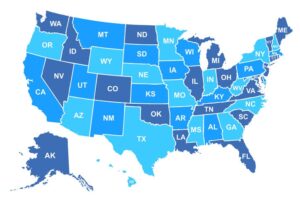What Happens In The US If You Go To The Hospital And Have No Insurance?

The healthcare system in the United States is notoriously complicated, and navigating it without insurance can be a daunting and overwhelming experience.
While no one plans to get sick or injured, it’s important to understand what happens if you find yourself in a situation where you need medical attention but don’t have insurance.
In this blog post, we will explore what happens in the US if you go to the hospital and have no insurance. From the costs involved to the options available, we’ll provide you with a comprehensive guide to help you navigate this complex system.
What Happens In The US If You Go To The Hospital And Have No Insurance?
If you go to the hospital in the United States without insurance, you may be in for a shock when you receive your medical bills. Unlike many other countries with universal healthcare systems, the US does not have a centralized government-funded healthcare program. Instead, healthcare is largely privatized, with insurance companies and hospitals negotiating rates and coverage. This means that without insurance, you may be responsible for paying the full cost of your medical care out of pocket.
The cost of healthcare in the US can be staggering, and it’s not uncommon for a single hospital visit to result in tens of thousands of dollars in medical bills. Even routine procedures and tests can add up quickly. If you are unable to pay your medical bills, hospitals may send your account to a collections agency, which can negatively impact your credit score and make it more difficult for you to access credit in the future.
However, there are options available for those without insurance. Many hospitals have financial assistance programs for low-income patients, which can help to reduce or even eliminate the cost of medical care. Additionally, some states have their own programs to provide healthcare coverage for low-income individuals and families. In some cases, hospitals may be willing to negotiate payment plans or offer discounts to patients without insurance.
It’s important to note that emergency medical care is always available to those in need, regardless of their insurance status or ability to pay. The Emergency Medical Treatment and Active Labor Act (EMTALA) requires hospitals to provide emergency medical care to anyone who comes to the emergency room, regardless of their insurance status or ability to pay.
Overall, if you go to the hospital in the US without insurance, you may be responsible for paying the full cost of your medical care out of pocket. However, there are options available to help reduce the cost, including financial assistance programs and state-run healthcare programs. Emergency medical care is always available to those in need, regardless of insurance status.
How Do Healthcare Costs In The US Compare To Other Countries With Universal Healthcare Systems?
Healthcare costs in the US are significantly higher than those in other countries with universal healthcare systems. According to a report by the Organization for Economic Cooperation and Development (OECD), the US spends over 16% of its GDP on healthcare, while the average spending among other OECD countries is around 8%.
One reason for the high costs of healthcare in the US is the fact that it is largely privatized, with insurance companies and hospitals negotiating rates and coverage. This has led to a fragmented system with high administrative costs, as well as a lack of price transparency, making it difficult for patients to compare costs and make informed decisions about their healthcare.
Another factor contributing to high healthcare costs in the US is the high cost of prescription drugs. Pharmaceutical companies in the US are allowed to set their own prices, which can be significantly higher than in other countries with price controls on prescription drugs.
In contrast, countries with universal healthcare systems, such as Canada and the UK, have lower healthcare costs due to centralized government-funded healthcare programs. This allows for greater price control and a more efficient healthcare system with lower administrative costs.
Overall, the high cost of healthcare in the US can be a major barrier for individuals without insurance or with inadequate insurance coverage. Understanding the factors contributing to these costs and exploring options for reducing medical bills can help individuals navigate the complex healthcare system in the US.
What Are Some Common Medical Procedures That Can Result In High Medical Bills For Those Without Insurance?
There are several common medical procedures that can result in high medical bills for those without insurance in the US, such as:
Emergency room visits: Emergency room visits are typically the most expensive type of medical care, and can easily result in bills of thousands or even tens of thousands of dollars. This is especially true if the visit involves tests, imaging, or other procedures.
Hospital stays: Hospital stays can also be very expensive, with costs depending on the length of stay and the procedures performed. Surgeries, in particular, can add significantly to the cost of a hospital stay.
Imaging tests: Imaging tests such as MRIs and CT scans can be very expensive, often costing thousands of dollars per test. Without insurance, patients may have to pay the full cost out of pocket.
Cancer treatments: Cancer treatments such as chemotherapy and radiation therapy can be very expensive, often costing tens of thousands of dollars per treatment course.
Prescription medications: Prescription medications can also be very expensive, especially for brand-name drugs that do not have generic alternatives. Patients without insurance may have to pay the full cost of these medications out of pocket.
Dental procedures: Dental procedures, especially major procedures such as root canals and crowns, can also be very expensive. Without insurance, patients may have to pay the full cost of these procedures out of pocket.
Overall, the cost of medical procedures in the US can be very high, and those without insurance may struggle to afford necessary care. It’s important to explore options for reducing medical bills, such as financial assistance programs or negotiating payment plans with healthcare providers.
Can You Negotiate Medical Bills With Hospitals And Doctors If You Don’t Have Insurance?
Yes, it is possible to negotiate medical bills with hospitals and doctors even if you don’t have insurance. Here are some steps you can take to negotiate your medical bills:
Contact the hospital or healthcare provider: If you receive a bill that you cannot afford, contact the hospital or healthcare provider as soon as possible. Explain your situation and ask if they offer any discounts, payment plans, or financial assistance programs.
Review your bill: Before you begin negotiating, carefully review your bill to ensure that all charges are accurate and that you are not being charged for services you did not receive. If you find errors, bring them to the attention of the hospital or healthcare provider.
Be prepared to negotiate: When you contact the hospital or healthcare provider, be prepared to negotiate. Explain your financial situation and ask if they are willing to reduce the amount you owe. You may be able to negotiate a payment plan or a lump-sum payment that is less than the full amount.
Consider hiring a medical billing advocate: If you are having difficulty negotiating your medical bills, consider hiring a medical billing advocate. These professionals specialize in helping patients navigate the complex healthcare billing system and can often negotiate on your behalf to reduce your medical bills.
Look for outside resources: If you are still struggling to pay your medical bills, look for outside resources such as charitable organizations or crowdfunding platforms that can help you raise funds to pay for your medical expenses.
While negotiating medical bills can be challenging, it is often possible to reduce your healthcare costs if you are willing to be proactive and persistent. By taking these steps, you can increase your chances of getting the help you need to pay for your medical expenses, even if you don’t have insurance.
What Are Some Resources Available To Help People Without Insurance Pay For Medical Bills?
If you don’t have insurance and are struggling to pay your medical bills, there are several resources available that can help you pay for medical bills if you have no insurance:
Financial assistance programs: Many hospitals and healthcare providers offer financial assistance programs that can help you pay for your medical bills. These programs are typically based on your income and may provide discounts, payment plans, or even free care.
Government programs: Depending on your income and circumstances, you may be eligible for government programs such as Medicaid, Medicare, or CHIP (Children’s Health Insurance Program). These programs can help cover the cost of medical care, including hospital visits, doctor’s appointments, and prescription medications.
Charitable organizations: There are several charitable organizations that provide financial assistance to individuals who are struggling to pay for medical bills. Some examples include the American Cancer Society, the National Patient Advocate Foundation, and the Patient Access Network Foundation.
Crowdfunding platforms: Crowdfunding platforms such as GoFundMe and YouCaring can be a helpful way to raise funds to pay for medical expenses. These platforms allow you to create a fundraising page and share it with friends, family, and the community to ask for donations.
Negotiation with healthcare providers: As mentioned in the previous question, you can also negotiate with healthcare providers to reduce your medical bills. You can ask for discounts, payment plans, or even a reduction in the total amount you owe.
Overall, there are several resources available to help you pay for medical bills if you don’t have insurance. It’s important to explore all of your options and to be proactive in seeking help to ensure that you can access the care you need without facing overwhelming financial burdens.
How Can Lack Of Insurance Affect Your Access To Preventative Care And Other Non-Emergency Medical Services?
Lack of insurance can significantly affect your access to preventative care and other non-emergency medical services. Here are some of the ways that this can happen:
Limited access to primary care providers: Without insurance, it can be difficult to find and afford regular visits with a primary care provider. This can lead to missed opportunities for preventative care such as routine check-ups, cancer screenings, and vaccinations.
Higher out-of-pocket costs: Without insurance, you may have to pay out-of-pocket for medical services, including preventative care. This can be prohibitively expensive, leading many people to skip necessary medical care.
Limited access to specialist care: Access to specialist care may be limited without insurance, which can impact your ability to receive specialized preventative care and management of chronic conditions.
Limited access to prescription medications: Prescription medications can be expensive without insurance, making it difficult to manage chronic conditions or to prevent the onset of disease.
Delayed care: Without insurance, many people delay seeking medical care until their condition becomes a medical emergency. This can lead to more serious health problems and higher healthcare costs in the long run.
Overall, lack of insurance can create significant barriers to accessing preventative care and other non-emergency medical services. It is important to explore all available options for obtaining insurance coverage, including government programs, employer-sponsored plans, and private insurance, to ensure that you can access the care you need to stay healthy.
Are There Any Government Programs Or Initiatives In Place To Address The Issue Of Uninsured Individuals In The US?
Yes, there are several government programs and initiatives in place to address the issue of uninsured individuals in the US. Here are a few examples:
Affordable Care Act (ACA): The ACA, also known as Obamacare, was signed into law in 2010 with the goal of expanding access to affordable health insurance. The law created health insurance marketplaces where individuals can purchase private insurance plans, often with subsidies to help cover the cost.
Medicaid: Medicaid is a joint federal-state program that provides health coverage to low-income individuals and families. Eligibility for Medicaid varies by state, but generally includes low-income adults, pregnant women, children, and individuals with disabilities.
Children’s Health Insurance Program (CHIP): CHIP is a federal-state program that provides health coverage to children and teens from low-income families. Eligibility for CHIP varies by state, but generally includes children from families with incomes too high to qualify for Medicaid but too low to afford private insurance.
Medicare: Medicare is a federal health insurance program that provides coverage to individuals over the age of 65, as well as to individuals with certain disabilities or conditions.
Community Health Centers: Federally funded community health centers provide primary and preventative care services to underserved populations, including uninsured individuals. They offer services on a sliding fee scale based on income and also provide assistance with enrolling in insurance programs.
Overall, these programs and initiatives aim to improve access to affordable health insurance in the US and healthcare services for uninsured individuals in the US. It is important to explore all available options to ensure that you and your family have access to the care you need.
Conclusion
In conclusion, the issue of uninsured individuals in the US is a complex and challenging problem that affects millions of people every year. When someone goes to the hospital without insurance, they may be faced with high medical bills that can be difficult to manage, leading to financial instability and even bankruptcy. However, it is important to note that there are resources and options available to help individuals without insurance manage these costs and access the care they need.
One of the key factors that contributes to the high cost of healthcare in the US is the lack of a universal healthcare system. Unlike many other developed countries, the US does not have a single-payer healthcare system that provides coverage for all citizens. Instead, the US relies on a complex web of public and private insurance programs, leaving many people without coverage.
This lack of health insurance coverage can have serious consequences for individuals and families, as it limits their access to preventative care, regular check-ups, and other important medical services. This, in turn, can lead to more serious health problems that require emergency care, resulting in higher healthcare costs overall.
Fortunately, there are government programs and initiatives in place that aim to address this issue, including the Affordable Care Act, Medicaid, and the Children’s Health Insurance Program. Additionally, community health centers provide access to primary and preventative care services for underserved populations, including uninsured individuals.
It is important for individuals without health insurance in the US to explore all available options for obtaining coverage and managing medical costs, including negotiating medical bills, seeking financial assistance, and applying for government programs. While the issue of uninsured individuals in the US is a complex problem, there are resources and support available to help people access the care they need and avoid the financial burden of high medical bills.



